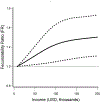Association of income and education with fecundability in a North American preconception cohort
- PMID: 32681982
- PMCID: PMC7541799
- DOI: 10.1016/j.annepidem.2020.07.004
Association of income and education with fecundability in a North American preconception cohort
Abstract
Purpose: The purpose of this study is to evaluate socioeconomic determinants of fecundability.
Methods: Among 8654 female pregnancy planners from Pregnancy Study Online, a North American prospective cohort study (2013-2019), we examined associations between socioeconomic status and fecundability (the per-cycle probability of conception). Information on income and education was collected via baseline questionnaires. Bimonthly follow-up questionnaires were used to ascertain pregnancy status. We estimated fecundability ratios (FRs) and 95% confidence intervals (CIs) using proportional probabilities regression, controlling for potential confounders.
Results: Relative to an annual household income of greater than or equal to $150,000, adjusted FRs were 0.91 (95% CI: 0.83-1.01) for less than $50,000, 0.99 (95% CI: 0.92-1.07) for $50,000-$99,000, and 1.09 (95% CI: 1.01-1.18) for $100,000-$149,000. FRs for less than 12, 13-15, and 16 years of education, relative to greater than or equal to 17 years, were 0.90 (95% CI: 0.76-1.08), 0.84 (95% CI: 0.78-0.91), and 0.89 (95% CI: 0.84-0.95), respectively. Slightly stronger associations for income and education were seen among older women.
Conclusions: Lower levels of education and income were associated with modestly reduced fecundability. These results demonstrate the presence of socioeconomic disparities in fecundability.
Keywords: Education; Fecundability; Income; Social determinants of health; Socioeconomic status; Time to pregnancy.
Copyright © 2020 Elsevier Inc. All rights reserved.
Figures


Similar articles
-
Socioeconomic status and fecundability in a Danish preconception cohort.Hum Reprod. 2023 Jun 1;38(6):1183-1193. doi: 10.1093/humrep/dead077. Hum Reprod. 2023. PMID: 37094974 Free PMC article.
-
Dietary phytoestrogen intakes of adult women are not strongly related to fecundability in 2 preconception cohort studies.J Nutr. 2020 May 1;150(5):1240-1251. doi: 10.1093/jn/nxz335. J Nutr. 2020. PMID: 31943053 Free PMC article.
-
Fecundability in relation to use of fertility awareness indicators in a North American preconception cohort study.Fertil Steril. 2019 Nov;112(5):892-899. doi: 10.1016/j.fertnstert.2019.06.036. Fertil Steril. 2019. PMID: 31731946 Free PMC article.
-
Menstrual cycle characteristics and fecundability in a North American preconception cohort.Ann Epidemiol. 2016 Jul;26(7):482-487.e1. doi: 10.1016/j.annepidem.2016.05.006. Epub 2016 May 31. Ann Epidemiol. 2016. PMID: 27449569 Free PMC article.
-
Female sleep patterns, shift work, and fecundability in a North American preconception cohort study.Fertil Steril. 2019 Jun;111(6):1201-1210.e1. doi: 10.1016/j.fertnstert.2019.01.037. Epub 2019 Apr 12. Fertil Steril. 2019. PMID: 30987736 Free PMC article.
Cited by
-
Socioeconomic status and fecundability in a Danish preconception cohort.Hum Reprod. 2023 Jun 1;38(6):1183-1193. doi: 10.1093/humrep/dead077. Hum Reprod. 2023. PMID: 37094974 Free PMC article.
-
Residential Proximity to Oil and Gas Development and Mental Health in a North American Preconception Cohort Study: 2013-2023.Am J Public Health. 2024 Sep;114(9):923-934. doi: 10.2105/AJPH.2024.307730. Epub 2024 Jul 11. Am J Public Health. 2024. PMID: 38991173 Free PMC article.
-
The Relationship Between Contraceptive Method Use and Return of Fecundity Among Women Attempting Pregnancy in Low- and Middle-Income Countries.Demography. 2023 Aug 1;60(4):1163-1179. doi: 10.1215/00703370-10877719. Demography. 2023. PMID: 37449662 Free PMC article.
-
Association Between Neighborhood Disadvantage and Fertility Among Pregnancy Planners in the US.JAMA Netw Open. 2022 Jun 1;5(6):e2218738. doi: 10.1001/jamanetworkopen.2022.18738. JAMA Netw Open. 2022. PMID: 35771576 Free PMC article.
-
Dietary Supplement Intake and Fecundability in a Singapore Preconception Cohort Study.Nutrients. 2022 Dec 1;14(23):5110. doi: 10.3390/nu14235110. Nutrients. 2022. PMID: 36501137 Free PMC article.
References
-
- Centers for Disease Control and Prevention. CDC Health Disparities and Inequalities Report--United States, 2013. MMRW 2013; 62: 1–184. - PubMed
-
- 2015 National Healthcare Quality and Disparities Report and 5th Anniversary Update on the National Quality Strategy Rockville, MD: Agency for Healthcare Research and Quality; April 2016. AHRQ Pub. No. 16–0015.
-
- Kaplan G, Keil J. Socioeconomic factors and cardiovascular disease: a review of the literature. Circulation. 1993; 88:1973–98. - PubMed
Publication types
MeSH terms
Grants and funding
LinkOut - more resources
Full Text Sources

